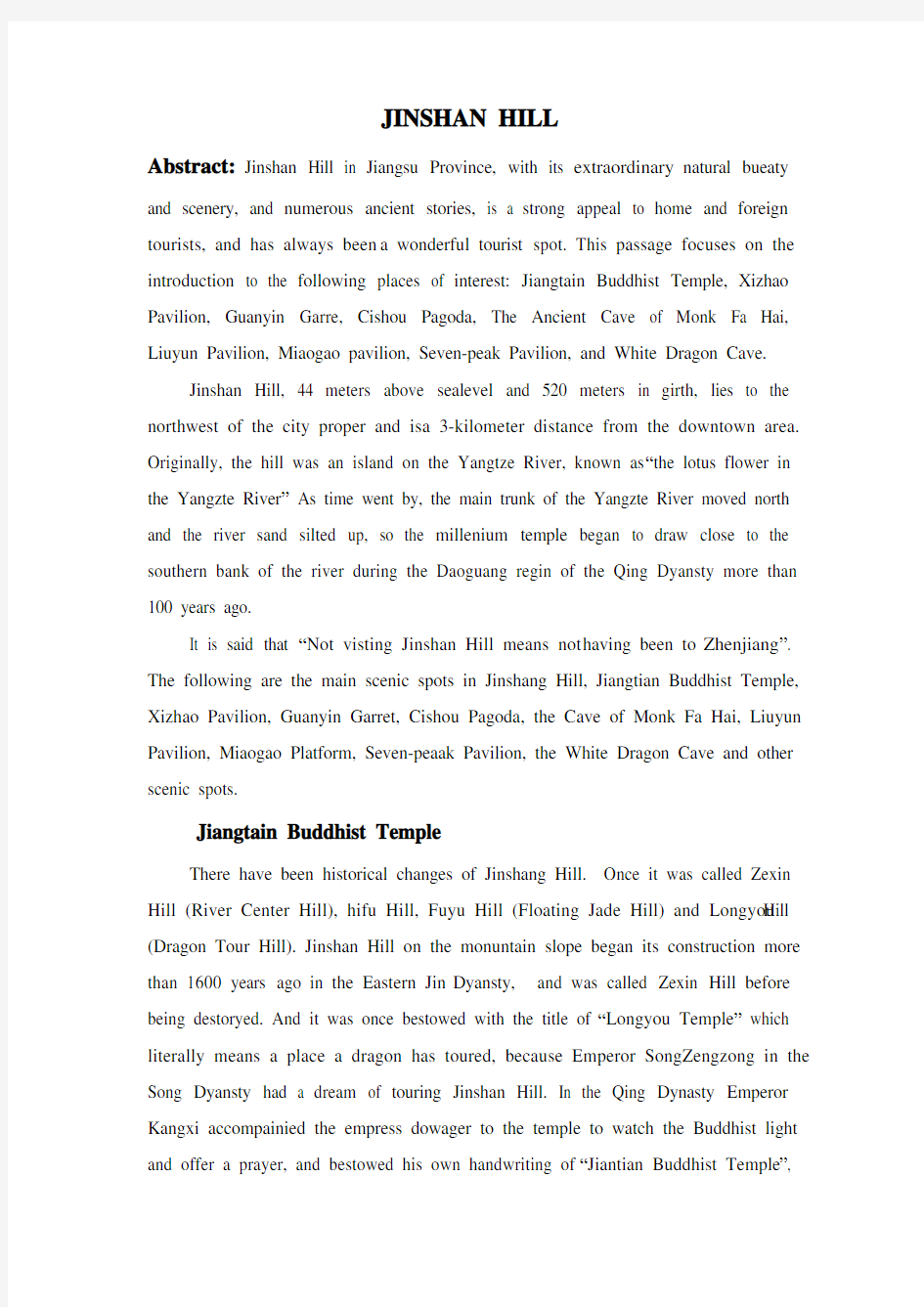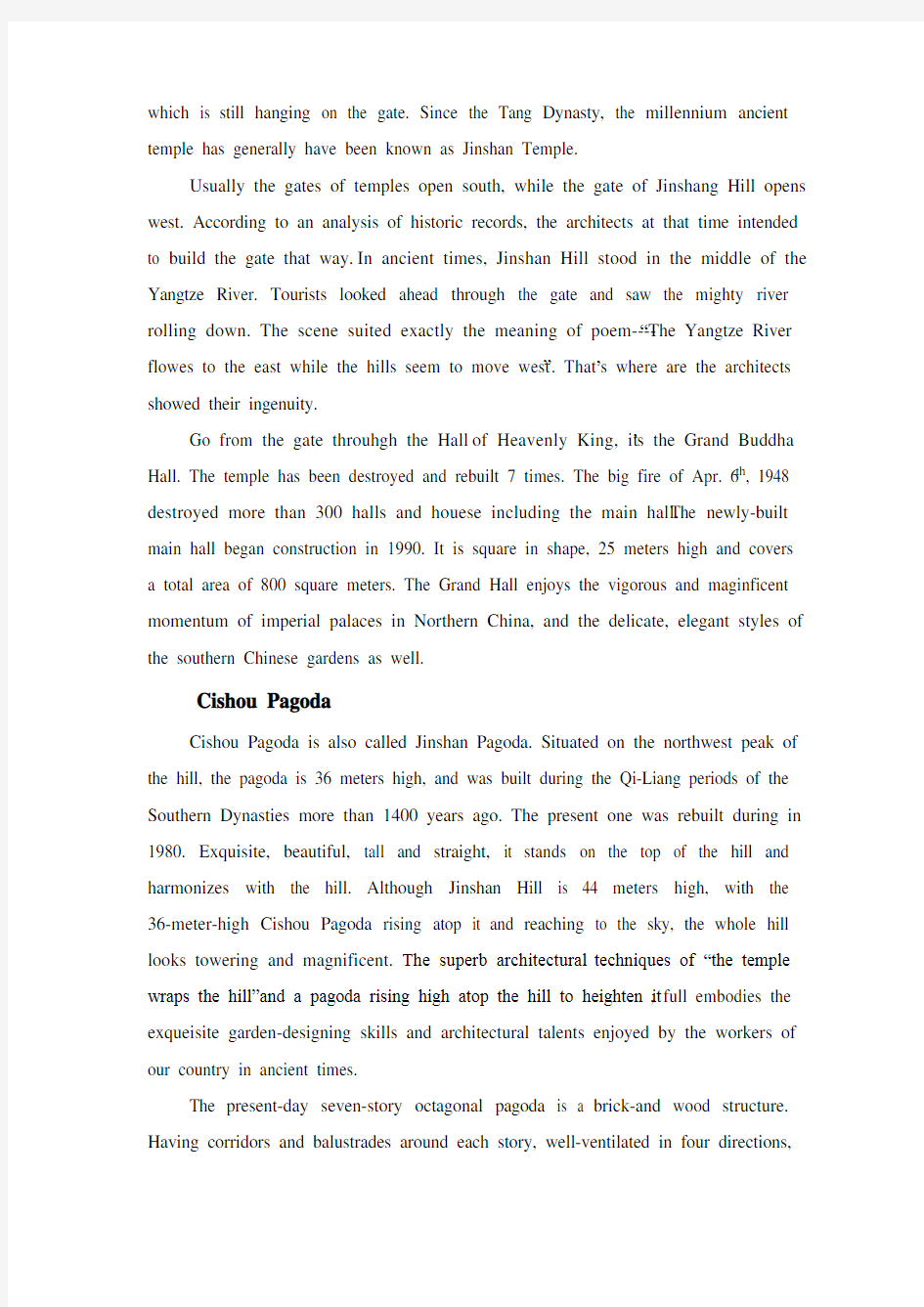中英文对照翻译镇江金山导游词


JINSHAN HILL
Abstract:Jinshan Hill in Jiangsu Province, with its extraordinary natural bueaty and scenery, and numerous ancient stories, is a strong appeal to home and foreign tourists, and has always been a wonderful tourist spot. This passage focuses on the introduction to the following places of interest: Jiangtain Buddhist Temple, Xizhao Pavilion, Guanyin Garre, Cishou Pagoda, The Ancient Cave of Monk Fa Hai, Liuyun Pavilion, Miaogao pavilion, Seven-peak Pavilion, and White Dragon Cave.
Jinshan Hill, 44 meters above sealevel and 520 meters in girth, lies to the northwest of the city proper and is a 3-kilometer distance from the downtown area. Originally, the hill was an island on the Yangtze River, known as “the lotus flower in the Yangzte River” As time went by, the main trunk of the Yangzte River moved north and the river sand silted up, so the millenium temple began to draw close to the southern bank of the river during the Daoguang regin of the Qing Dyansty more than 100 years ago.
It is said that “Not visting Jinshan Hill means not having been to Zhenjiang”. The following are the main scenic spots in Jinshang Hill, Jiangtian Buddhist Temple, Xizhao Pavilion, Guanyin Garret, Cishou Pagoda, the Cave of Monk Fa Hai, Liuyun Pavilion, Miaogao Platform, Seven-peaak Pavilion, the White Dragon Cave and other scenic spots.
Jiangtain Buddhist Temple
There have been historical changes of Jinshang Hill. Once it was called Zexin Hill (River Center Hill), hifu Hill, Fuyu Hill (Floating Jade Hill) and Longyou Hill (Dragon Tour Hill). Jinshan Hill on the monuntain slope began its construction more than 1600 years ago in the Eastern Jin Dyansty, and was called Zexin Hill before being destoryed. And it was once bestowed with the title of “Longyou Temple” which literally means a place a dragon has toured, because Emperor SongZengzong in the Song Dyansty had a dream of touring Jinshan Hill. In the Qing Dynasty Emperor Kangxi accompainied the empress dowager to the temple to watch the Buddhist light and offer a prayer, and bestowed his own handwriting of “Jiantian Buddhist Temple”,
which is still hanging on the gate. Since the Tang Dynasty, the millennium ancient temple has generally have been known as Jinshan Temple.
Usually the gates of temples open south, while the gate of Jinshang Hill opens west. According to an analysis of historic records, the architects at that time intended to build the gate that way. In ancient times, Jinshan Hill stood in the middle of the Yangtze River. Tourists looked ahead through the gate and saw the mighty river rolling down. The scene suited exactly the meaning of poem----“The Yangtze River flowes to the east while the hills seem to move west”. That’s where are the architects showed their ingenuity.
Go from the gate throuhgh the Hall of Heavenly King, it’s the Grand Buddha Hall. The temple has been destroyed and rebuilt 7 times. The big fire of Apr. 6th, 1948 destroyed more than 300 halls and houese including the main hall. The newly-built main hall began construction in 1990. It is square in shape, 25 meters high and covers a total area of 800 square meters. The Grand Hall enjoys the vigorous and maginficent momentum of imperial palaces in Northern China, and the delicate, elegant styles of the southern Chinese gardens as well.
Cishou Pagoda
Cishou Pagoda is also called Jinshan Pagoda. Situated on the northwest peak of the hill, the pagoda is 36 meters high, and was built during the Qi-Liang periods of the Southern Dynasties more than 1400 years ago. The present one was rebuilt during in 1980. Exquisite, beautiful, tall and straight, it stands on the top of the hill and harmonizes with the hill. Although Jinshan Hill is 44 meters high, with the 36-meter-high Cishou Pagoda rising atop it and reaching to the sky, the whole hill looks towering and magnificent. The superb architectural techniques of “the temple wraps the hill”and a pagoda rising high atop the hill to heighten it, full embodies the exqueisite garden-designing skills and architectural talents enjoyed by the workers of our country in ancient times.
The present-day seven-story octagonal pagoda is a brick-and wood structure. Having corridors and balustrades around each story, well-ventilated in four directions,
and sights in all directions, the pagoda enbles you to enjoy a different view on each story. Wang Anshi, the famous writer of Song Dynasty, once wrote a poem to describe this view----“The seven-story pagoda rests on layers of rocks, Wind comes round from all directions when the windows open;See birds flying on the flat grounds, and suddenly you realize you are standing onn half the sky.”
On the lattice outside the pagoda are inscribed the four characters of “Tian Di Tong Geng”(Heaven and eart are of the same age), written by Li Yuanan, an eight-year-old boy of Hunan Province during the Guangxu Reign of the Qing Dyansty. Then why did the boy write these characters and why did they appear under the pagoda?Among the people circulates such a story:
When Empress dowager Ci Xi celebrated her sixtieth birthday, the officials all over the country came to the capital to congratulate her with gengerous gifts. Liu Kunyi, governor of tow Jiangs----Jiansu and Zhenjiang Provinces, got the news that Master of Law Yin Ru, the Buddhist Abbot of Jinshan Hill, had just rebuilt Cishou Pagoda. So he thought: “Why can’t I make full use of it?” After making up his mind, he came to the capital. Seeing Liu Kunyi brought nothing, the empress dowager pulled a long facd, The governor hastened to kneel down and say: “Queen mother, in order to celebrate your birthday, I specially built a pagoda called Cishou in Jinshan Hill, Zhenjiang, a famous scenic spot in the south of the Yangtze River, to wish you longevity.” Hearing this, Ci Xi was wild with joy. suddenly she asked Liu: “Since you wish me a longer life, noe can yo u tell me how long I will live?” The governor was stumped and trembled with fear. While he was in a dilemma, his eight-year-old boy, called Li Yuanan, quietly handed him a piece of paper. Liu cast a glance at it and as if he’d found a priceles s treasure, he quickly submitted it with his two hands. Ci Xi was all smiles when she read it, for the note had these four characters”Tian Di Tong Geng”. So the empress dowager genterously rewarded the governor. Afterwards these four characters were inscribed on Cishou Pagoda.
White Dragon Cave
On the foot of the northwest side of the hill, there is an ancient cave, with the
four seal characters of “Ancient White Dragon Cave”inscribed on the wall. According to the records by “Biographies of Eminent Monks” of the Song Dynasty, a white boa used to hide in the cave. It would send out fog-like poisonous gas. No one dared to enter the cave. In the Tang Dynasty, an eminent monk called Ling Tan came to Jinshan and sat in the mediation inside the cave. Because he had superior attainments, the white boa fled hurriedly.
However, in the folk myth legend, the cave is related to the story of “White Lady Snake Drives Floods to Submerge Jinshan Temple”. It’s said that once Scholar Xu Xian was tricked to Jinshan by Fa Hai. His wife, White Lady Snake, together with Xiao Qing, her servant girl, came here by boat, asking Fa Hai to free her husband for a family reunion. The monk turned a deaf ear to her. So Lady Snake was forced to exercise magic powers against him. She asked the dragon kings of the four seas and their crab general and shrimp soldiers for help. The dragon kings brought water to sumberge the temple on the hill. Monk Fa Hai took off his kasaya, throwing it outside the gate. A golden light flashed and the kasaya turned into a long dyke, keeping off the surging waters. Lady Sanke failed in the fight and had to retreat to the West Lake, Hangzhou, awaiting opportunities for revenge.
While Jinshan Hill was being submerged by floods, Xu Xian, who was locked inside the pagoda, was dying to see his wife. His pregnant wife was at that time fighting against Fa Hai. A little monk guarding the pagoda sympathized with him very much. He guided Xu Xian away from the White Dradon Cave. After leaving the cave, Xu walked a long, long distance and finally reached the end----the Broken Bridge of Hangzhou, where his wife and the servant had been expecting him a long time. This is the story of Meeting on the Broken Bridge acted on stage.
